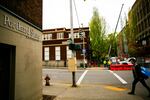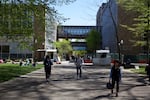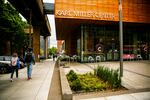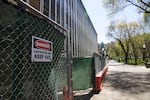For years, Portland State University has been that row of low, brick-and-concrete bunkers along Southwest Broadway.

Cranes and construction crews have become a regular sight at Portland State University's downtown campus.
Rob Manning / OPB
PSU business school student Elliott Dow saw the old business building as dark and cramped.
“You went there for classes," he said, "and then you got out."
On one hand, business school dean Cliff Allen defends the building as having served its general purpose. But Allen also acknowledges that the facility didn't support specific teaching methods. It lacked spaces, for example, where students could collaborate on business case studies.
"It used to be people would literally go to their car in a parking garage, work together and then come back," Allen said. "And the professors couldn't walk around and help each team because they were scattered elsewhere."
University administrators see little choice but to rebuild and renovate academic buildings to meet current demands. At the same time, across the country, higher education is wrestling with rising costs and increased competition. Those lessons were reinforced earlier this month a few miles away from Portland State when administrators at private Marylhurst University announced that the school would close.
Part of Portland State's key to success has been to remain reasonably priced. While PSU has prioritized keeping tuition costs affordable, leaders have approved regular tuition increases, along with the state's other public universities. This year, PSU trustees approved a nearly 4 percent increase, after deciding against a slightly larger increase. That follows a protracted debate in 2017, as Portland State and the University of Oregon had to justify increases to the Higher Education Coordinating Commission, which initially opposed the hikes. PSU boosted tuition by 8.4 percent in 2017.
PSU lists tuition for 2018-19 as $9,223 for in-state undergraduate students. That's substantially lower than Oregon State University's Corvallis and Cascades campuses ($11,070) and the University of Oregon ($11,898), though PSU is more expensive than the three regional, public universities.
PSU’s campus overhaul has already cost hundreds of millions of dollars, largely from state-backed bonds and philanthropic gifts rather than student tuition.
As costs rise for students and institutions, Oregon’s public universities see the millions of dollars they're spending to expand and improve as key to higher education's successful future.
Leaders at PSU say the nine-figure construction effort is intended to serve the university's mission of a quality, affordable education that prepares students for today's workforce.

Portland State University president Rahmat Shoureshi looks out from his office, atop one of the campus' newer buildings.
Rob Manning / OPB
"It’s to make sure that our students have access and get education in a state-of-the-art environment,” said PSU president Rahmat Shoureshi.
There is an argument for creating facilities that students actually want to spend time in, rather than "get in and get out" the way Dow used to prefer. University counselors will tell you that students who spend more time on campus are more likely to graduate.
The trick is to build those modern facilities without breaking the bank.
Often that means quietly, almost invisibly, taking the less expensive route. Look at PSU’s brand-new Peter Stott Center — the $51 million athletic building. The new basketball arena is meant to draw students and off-campus fans to the heart of campus. It looks profoundly different from the old athletic center, but a lot of areas were repurposed and renovated, said associate vice president Dan Zalkow.
“The areas that we kept, there was nothing particularly special or interesting about them, but there were a lot of areas that functionally could work well," Zalkow said. "Where the swimming pool was, it was a nice double-height space that works perfectly for a weight room, and it’s a beautiful space.”

From left, Ron Blaj, Dan Zalkow and Jason Franklin - three of the leaders of Portland State University's campus overhaul - stand in front of the new Peter Stott Center in April 2018.
Rob Manning / OPB
Reusing and repurposing the buildings also has the benefit of supporting PSU's environmental goals, said campus planning director Jason Franklin.
"Many cases, it’s the sustainable thing to do — to renovate instead of build new,” Franklin said.
Occasionally, it might make sense financially to knock down a building and start over rather than fix up the old one. Oregon school districts, including Portland Public Schools, have done that at times as they update decades-old buildings. But at PSU?
“Demolishing and building new has never come out on top from an economical standpoint,” said Ron Blaj, the university's director of capital projects and construction.
On a recent tour, Zalkow walked along the South Park Blocks through the middle of Portland State's campus pointing out buildings that were either getting rebuilt or would be soon ... he hoped.

Students walk across the South Park blocks in the heart of Portland State University's downtown campus.
Rob Manning / OPB
“After the Stott Center, next will be Neuberger Hall, where we’re replacing the facade along the Park Blocks with a new, nice entrance on the park, where there is none now," he said.
With orange construction barriers around it, Neuberger Hall is inaccessible as crews gut it and rebuild inside. It wasn't much easier to get inside before then; Neuberger is one of several modernist PSU buildings with recessed doors that can be hard to find.
"Cramer Hall is another one that we hope to do — have a major renovation," Zalkow said.
Then with a laugh, he said, "That also turns its back, pretty much to all sides of the building.”
Rather than turning their backs, PSU officials want the new buildings to open their arms to the surrounding neighborhoods.
PSU’s physical changes reflect how the institution is evolving. Its core mission of providing an affordable education is remaining, like the bones of the campus buildings being renovated. But everything else is modernizing.
Remember Elliott Dow, who avoided too much time in the old business building? He likes what's taken its place: the Karl Miller Center, which features a bright atrium, open stairways and retail spots.

PSU's business school has traded out a stark, modern building for its more approaching new Karl Miller Center, including retail space along SW Broadway.
Rob Manning / OPB
Dow said the new center is making him a better student.
“I have always had problems with motivation if I had to go home right after classes and have to do homework there or study there," he said. "[Now] you can study, you can sit down and meet with classmates, you’re going to get work done at a better rate, possibly higher quality.”
The $60 million Miller Center combines new features like the big glass atrium with a major renovation of the old building. Construction crews had to open up the walls, install new wiring to meet electrical needs of the technology, such as interactive screens geared for 21st century commuter students.
“Students can dial in on Google Hangouts and become part of the class," said Allen, the business dean. "There’s nothing more stressful than having a 5:30 class and they work in Hillsboro. If they’re called into a meeting at 5:00, they’re not going to miss class because they can go right back to their cubicle or their office and dial in.”
Allen acknowledges that overhauling the building became a necessity in the increasingly competitive world of higher education business offerings across the country.
“The building is somewhat of a requirement for a business school today — if you look across the country — many, many business schools are building new buildings,” said Allen.

Orange barriers and caution signs surround Neuberger Hall, the latest Portland State University building to undergo major renovations, in 2018.
Rob Manning / OPB
With a slate of aging buildings, Portland State is on a long cycle of rebuilding and renovating. It started a decade ago when PSU overhauled Lincoln Hall and erected a glass wall facing Broadway. The work continues today with the mostly administrative Neuberger Hall, still more than a year from completion. Next up, with $51 million in bond funds, PSU plans to build a new home for the Graduate School of Education in a building listed on the drawing board as just "Fourth and Montgomery." Right now it's a parking lot.
University leaders say all these investments will pay off in attracting more students, recruiting and retaining faculty and reassuring another increasingly important constituent group: research funders.
